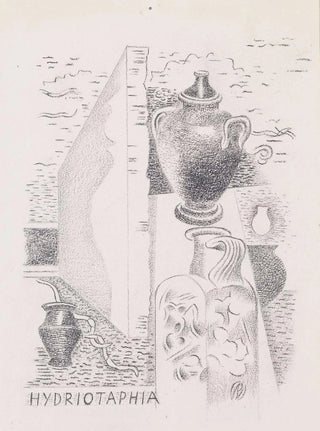Art print | Hydriotaphie - Paul Nash


View from behind

Frame (optional)
Hydriotaphy Art print - Paul Nash – Captivating introduction
The artwork "Hydriotaphie" by Paul Nash awakens in us a deep fascination, an invitation to explore the twists and turns of memory and nature. In this canvas, the artist manages to capture the very essence of life and death, evoking a dialogue between the tangible and the ephemeral. The depicted scene, both dreamlike and realistic, transports us to a universe where time seems to have stopped, where each element tells a story. By contemplating this piece, the viewer is invited to reflect on their own relationship with the world, nature, and art, while immersing themselves in the unique atmosphere that Nash has skillfully created.
Style and uniqueness of the work
Paul Nash's style in "Hydriotaphie" is characterized by a palette of delicate colors, where shades of earth and sky blend harmoniously. Organic shapes, both soft and angular, evoke the duality of life and death, while light plays a central role in the composition. Nash masters the art of suggestion, leaving it to the viewer to interpret the symbols present in his painting. Natural elements, such as bare trees and desolate landscapes, serve as reminders of the fragility of human existence. This work stands out for its ability to evoke deep emotions, to inspire reflection on our place in the world and our relationship with the environment.
The artist and his influence
Paul Nash, an emblematic figure of the surrealist movement and British landscape art, knew how to leave his mark on his era through his innovative approach to art. Born in 1889, he experienced the tumult of the 20th century, drawing inspiration from historical events and social transformations to nourish his work. Nash was influenced by the horrors of World War I, which profoundly impacted his work and artistic vision. Through "Hydriotaphie," he explores themes of collective memory and nature, while fitting into an artistic tradition that questions the relationship between man and his environment. His influence endures today, inspiring many contemporary artists who seek to capture the essence of life through

Matte finish

View from behind

Frame (optional)
Hydriotaphy Art print - Paul Nash – Captivating introduction
The artwork "Hydriotaphie" by Paul Nash awakens in us a deep fascination, an invitation to explore the twists and turns of memory and nature. In this canvas, the artist manages to capture the very essence of life and death, evoking a dialogue between the tangible and the ephemeral. The depicted scene, both dreamlike and realistic, transports us to a universe where time seems to have stopped, where each element tells a story. By contemplating this piece, the viewer is invited to reflect on their own relationship with the world, nature, and art, while immersing themselves in the unique atmosphere that Nash has skillfully created.
Style and uniqueness of the work
Paul Nash's style in "Hydriotaphie" is characterized by a palette of delicate colors, where shades of earth and sky blend harmoniously. Organic shapes, both soft and angular, evoke the duality of life and death, while light plays a central role in the composition. Nash masters the art of suggestion, leaving it to the viewer to interpret the symbols present in his painting. Natural elements, such as bare trees and desolate landscapes, serve as reminders of the fragility of human existence. This work stands out for its ability to evoke deep emotions, to inspire reflection on our place in the world and our relationship with the environment.
The artist and his influence
Paul Nash, an emblematic figure of the surrealist movement and British landscape art, knew how to leave his mark on his era through his innovative approach to art. Born in 1889, he experienced the tumult of the 20th century, drawing inspiration from historical events and social transformations to nourish his work. Nash was influenced by the horrors of World War I, which profoundly impacted his work and artistic vision. Through "Hydriotaphie," he explores themes of collective memory and nature, while fitting into an artistic tradition that questions the relationship between man and his environment. His influence endures today, inspiring many contemporary artists who seek to capture the essence of life through






